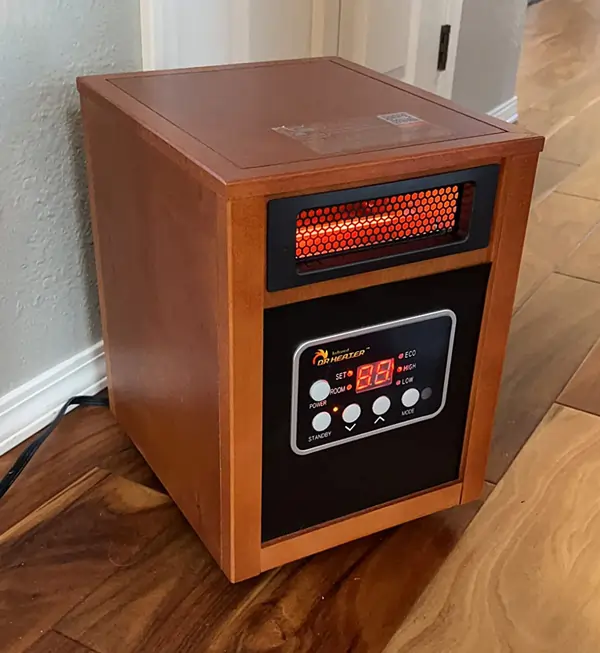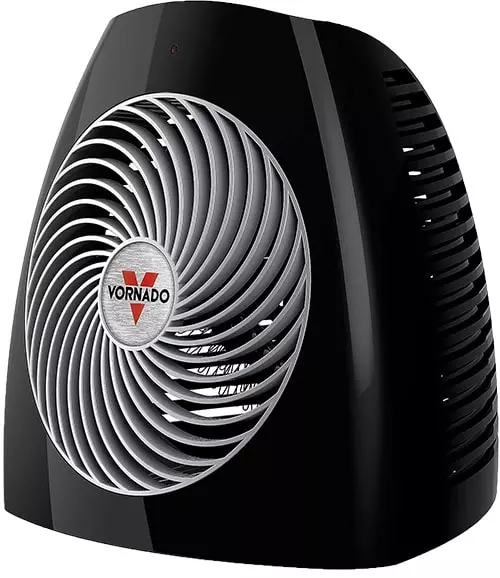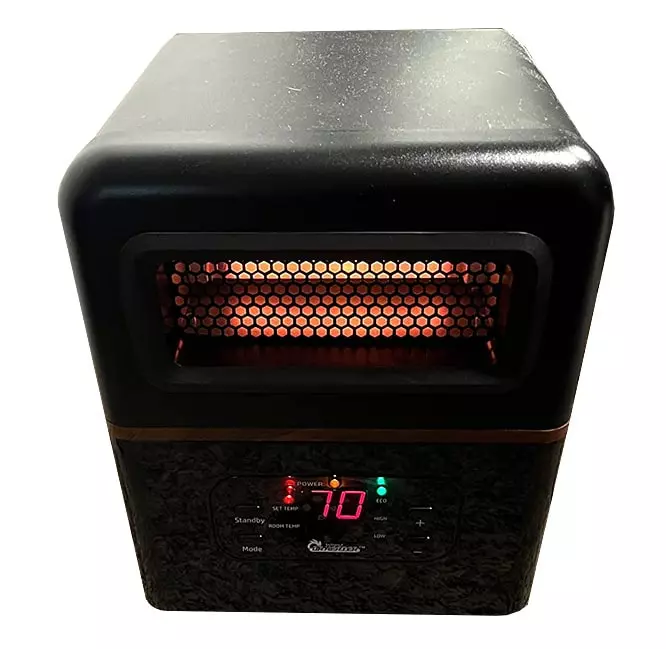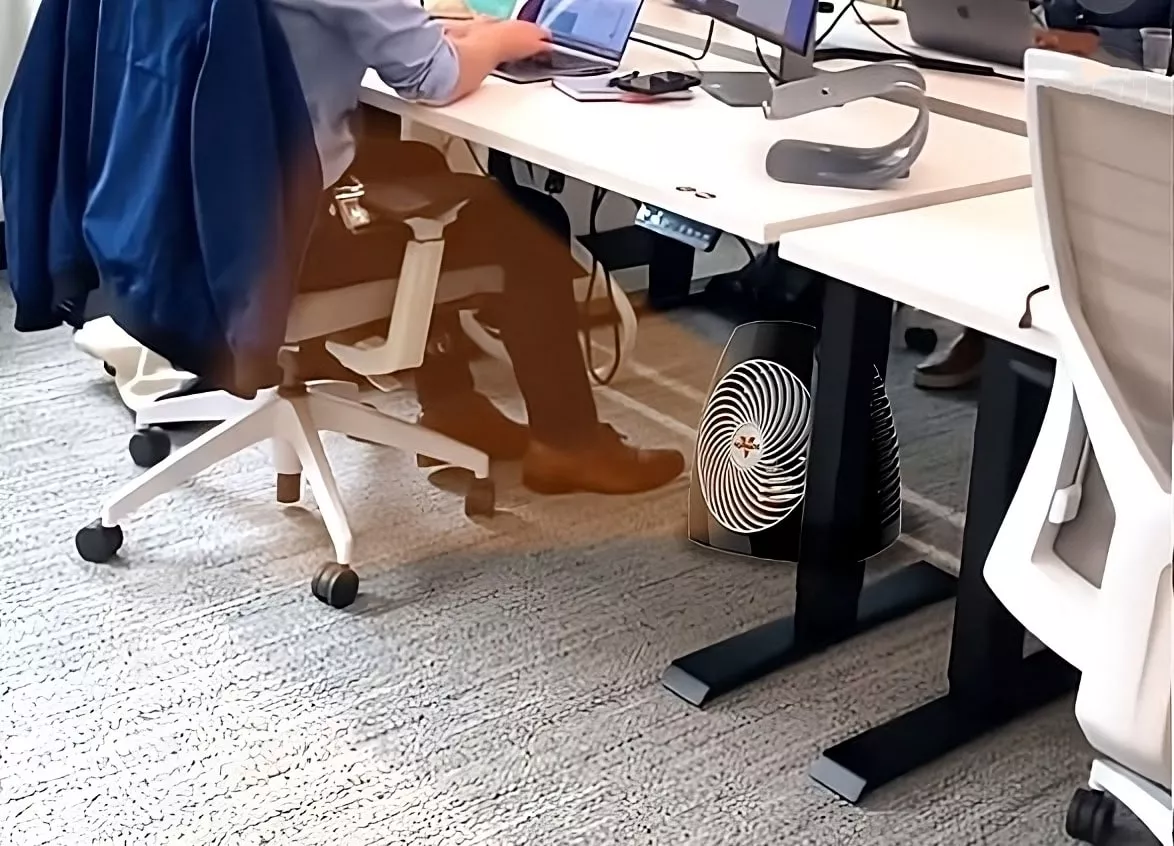Heating in the office can be unnecessarily complex, especially when using space heaters. Most workplaces either prohibit or limit the use of space heaters. And if space heaters are allowed, they have to fit certain size criteria.
All these rules can get very annoying.
Since it’s practically impossible to heat an office to a temperature that suits everybody, space heaters can be a practical solution.
Hi! My name is Daniel, I am an electrical engineer by profession and I write about space heaters every day!
In this post, we will explore the best space heaters for various office setups, including cubicles, open-plan offices, and personal offices.
For offices where space heaters aren’t allowed at all, I am going to tell you about my favorite space heater alternative for offices.
And in the end, we’re going to also have a look at how to get your space heater approved!
So, let’s have a look:
What are the best space heaters for offices?
Offices are very diverse environments with people having different temperature preferences.
If you get a too large / too loud or too whatever space heater, someone might complain.
So, the decision-driving question is:
Which type of office are you working in? Are there other people?
Let’s have a look at different office setups and which space heaters are best for heating them:
1. Personal Office (corporate, or at home)
The by far simplest situation is a personal office. You don’t have to consider anyone else but you. And, ideally, you are at home or you don’t need anyone’s approval.
Or, you need someone’s approval in theory but nobody is enforcing rules on you in practice.
To heat a personal office any space heater will do.
Here are my recommendations:
Recommended infrared space heater for home offices
For home offices or for anyone in a high position, where people don’t question you, I highly recommend getting an infrared space heater.
Infrared heaters provide heat instantly. You don’t have to wait more than a few minutes for an infrared heater to output heat at full capacity.
My favorite infrared heaters are Dr Infrared heaters. They are not technically superior to other infrared heaters. But Dr Infrared has a long track of producing quality infrared heaters that are very durable and last you a long time.
There’s nothing more annoying than having to buy several space heaters because your initial choice was poor quality. Also, a single space heater is easier to write off as an office expense than multiple space heaters.
So, get a good space heater right away.
My recommended infrared heater for personal offices is the Dr Infrared DR968 (click here to view it on amazon).
This infrared heater comes with a remote (so you can control it from your desk) and is strong enough to heat even large offices.
Dr Infrared also offers a more extravagant model, the Dr Infrared DR998 Elite (click to see it on amazon), which has a built-in fan and humidifier. So, this one can be a good choice in dry areas.
But in general, my first recommendation (the first Dr Infrared heater linked) is more than enough for most personal offices!

Recommended space heater for corporate offices
In many corporate offices, bringing a space heater might raise eyebrows among coworkers. Especially, if it’s an infrared heater that glows red.
To avoid time-wasting conflict / discussion when someone spots your space heater, I recommend getting a space heater that does not scream “I am glowing red hot and can put Linda from HR’s documents on fire!” like an infrared heater.
Instead, my recommendation is to get a very safe space heater where you don’t see that it’s heating. You could call it a stealth heater.
The safest and most inconspicuous heater is this De’Longhi oil-filled radiator (click here to view it on amazon). It outputs a lot of heat and is very reliable. It does not even make a sound!
But this heater is heavy. So, carrying it into the office can be annoying. If possible, you can order it directly to your office.
A light stealth space heater is this Vornado MVH Vortex heater (click to view it on amazon). However, this one will make some noise because needs the built-in fan to distribute heat.

2. Cubicles & Open-plan offices
In cubicles and open-plan offices, heating can be troublesome. Multiple people share the same room, some feel warm, others feel cold. Everybody has different temperature preferences.
Recommended space heater for cubicles and open-plan offices
For these offices, I recommend getting a smaller-size infrared heater you can place under your desk.
My recommendation is this Dr Infrared DR-978 heater (click here to view it on amazon).
This one is a good choice, because it is easy to transport, outputs the same amount of heat as the strong heaters linked earlier (if you run it on the highest setting), and it fits neatly under your desk.
And on top of that, since it’s an infrared heater, you can run it at low power settings and still feel warm instantly.

You don’t have to get this specific infrared heater model. Any small infrared heater will do.
I like the Dr Infrared DR-978 however, because it’s so unsuspicious.
I have a cheap infrared heater at home that heats just as well at half the price. But it’s much larger and the glowing heating elements will trigger uneducated coworkers who are afraid of heat.
So, I’ll never bring it to the office.
3. Offices where space heaters are prohibited
“The only way that I ever got anyplace was by breaking some of the rules”.
Arnold Schwarzenegger
Another famous quote from Arnold is “break the rules, but not the law”.
So, if you don’t explicitly find a policy you personally signed on space heaters (or power electronics in general), but you heard Steve from IT spreading rumors that you can’t bring space heaters, you can do the following:
Obey the rules and don’t bring a space heater to the office: Recommended alternatives
If you are afraid of challenging rules, you shouldn’t bring a space heater. Even so, don’t listen to some random engineer on the internet (me) pushing you toward rule-breaking behavior.
After all, you have to pay your bills, not me.
If you are not allowed to bring a space heater, get a heating pad for your chair. Heating pads consume just a fraction of the power a space heater needs (75 Watts instead of 1,500 Watts), are much safer, and don’t violate office policies.
I recommend getting this heating pad(click here to view it on amazon). But to be honest, heating pads are all equal, and it doesn’t matter which option you go for.
Heating pads heat through contact (instead of distributing heat “through the air”, where much of it is lost) and, therefore, run on much lower power requirements.
Also, with a heating pad you will not heat the entire room. So, you will not disturb anyone’s temperature preferences.
It’s the ideal minimal-invasive heating solution for most offices with strict rules.
In fact, heating pads consume less power than many laptops. So, if you can plug a laptop into the wall outlet, you can surely plug in a heating pad.
If that’s not allowed, your workplace is nuts.
Ignore the rules and bring a space heater
Sometimes ignoring rules is the best way forward. Sometimes space heater prohibition just doesn’t make sense.
For example, when your office is relatively new, solidly built, and there are dozens of computers running at the same time (indicating the electric circuitry can withstand high power requirements).
In this case, get any of the space heaters recommended earlier.
Still, I’d say: Run the space heater on low power settings. Keep the space heater to yourself and don’t showcase it. And always turn it off when you leave.
You are fully responsible for all damages done.
Rule-proof wearable neck heaters for offices
One heater that does not violate any office rules is a wearable neck heater (click here to view it on amazon).
These neck heaters are battery-powered and rechargeable. So, you can charge yours at home, heat in the office, and bring it home with you again.
This way, it does not count as office equipment and, normally, you don’t need to get approval.
On top of that, you don’t even draw electricity from your office, which makes them even safer than heating pads.
It’s a wearable just like a watch or a smartphone.
Nobody ever questions these things.
How to get your space heater officially approved
If your workplace has a policy that strictly regulates the use of space heaters, you’ll need to get approval from the relevant authorities before you can start warming up your personal office space.
Here are some strategies to help you get your space heater officially approved:
Arguments to give your employer to allow space heater
- Energy Efficiency: Make the argument that modern space heaters are energy-efficient and can actually save the company money in heating bills, especially if the main heating system is generally cranked up to keep everyone warm (I’ll provide you specific calculations later)
- Productivity: You perform better in environments where you are comfortable.
- Being cold is a distraction that can affect productivity, which effectively decreases your employer’s profits.
- Safety Features: Explain that modern heaters come with safety features like tip-over protection, overheat protection, and timers.
- Personalized Comfort: Emphasize that a space heater allows for personalized temperature control, meaning the central heating system doesn’t have to work as hard to meet a broad range of temperature preferences.
Space Heater Certifications
Employers love hearing that your electronic devices have proper safety certifications, for example, one of those (depending on where the heater is manufactured):
- UL (Underwriters Laboratories)
- CSA (Canadian Standards Association)
- ETL (Intertek)
All the heaters recommended in this article have at least one of these certifications!
Quote:
“The Dr Infrared Heater is certified by Underwriters Laboratories (UL) and Canada, ensuring the highest safety standard.”
Dr Infrared Heater sales page
 The UL certification badge is printed on the packaging of safe & tested space heaters. Also, you can find out on the sales page of a heater whether it has this certification.
The UL certification badge is printed on the packaging of safe & tested space heaters. Also, you can find out on the sales page of a heater whether it has this certification.
( Except for the space heater alternatives: The neck warmer and the heating pad don’t have special certifications aside from the CE standard certification, since they are both low-power devices )
Safety Tips for Using a Space Heater in the Office
- Keep it Away from Flammable Materials: Always make sure the heater is at least 3 feet away from flammable materials like paper, cloth, or furniture.
I did an experiment on infrared heater ignition capability and found that infrared heaters can ignite plastics that are closer than 1 foot distance from the heating elements. - Use on a Flat Surface: Always place your heater on a flat, hard surface to minimize the risk of it tipping over.
Carpeted floor is fine for space heaters as well. I did an in-depth analysis of space heater heat distribution and different carpet material ignition temperatures before and found that space heaters can’t ignite carpets.
Certainly, they can’t harm the thinly carpeted floor in a typical office. - Never Leave it Unattended: Always turn off your space heater when you leave your workspace.
Space heater fires usually start in the absence of people. Leaving your heater running is inconsiderate both for the safety and the electricity bills of your workplace. - Regular Inspection: Regularly inspect the heater for any wear and tear, including the power cord. If the power cord looks worn or even gets hot, stop using it immediately.
Conclusion
Finding the right space heater for your office environment can be challenging but is well worth the effort.
From personal offices to cubicles and open-plan setups, there’s a space heater to fit your needs and preferences.
If your office prohibits the use of space heaters, consider alternatives like heating pads or wearable neck heaters, which offer a compromise without violating company policies.
Getting your space heater approved may require some effort on your part, including presenting a compelling case to your employer.
Safety should always be your top priority, so make sure to choose a space heater with the appropriate certifications and always adhere to safety guidelines.
Remember, the key to a comfortable and productive work environment is making it suit you, and a space heater can be a step in that direction.
Disclaimer: Always consult your workplace’s rules and regulations regarding the use of electrical devices. The recommendations made in this article are suggestions and may not comply with your specific workplace policies. You are solely responsible for your actions and possible causes.
